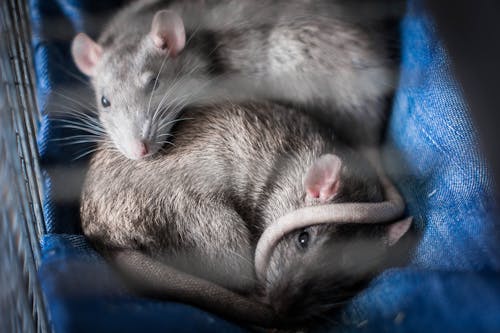As an Amazon Associate I earn from qualifying purchases.
Our Associate portal can be found here
Are you looking for a new method to get rid of varmint on your property? Night hunting offers new sets of challenges. You can spot, track and illuminate critters that appear in farmland, chicken coops, or other facilities in search of food. But is there any truth to the myth that hunting rats with red light increases your harvest success?
Rats have dichromatic vision, meaning they see only two colors: pale green, yellowish, and blue. When light is at the pale end of the spectrum, such as in reddish hues, it’s naturally less visible to them. You can search out these critters with minimal risk of being detected, giving you ample time to line up your shot.
Varmint overpopulation can cause headaches for you, primarily if you’re operating a farm or some other form of husbandry. Rats spoil crops and mess with your livestock, and you can tackle them with an airgun for light plinking. Let’s set the record straight by dividing if hunting these rodents with a red light trumps all other methods in terms of shot success.
Do Rats See Red Light Lamps, or Are They Color Blind?
Rodents lack the L-cones in their eye retinas, causing dichromatic vision instead of the trichromatic in humans. Far beyond the effects on their eyes, it’s been found that light causes substantial behavioral, psychological, and perception changes in animals. Rats see low wavelength illumination but have difficulty processing it from the other end of the spectrum.

Dichromatic vision rodents go blind in the range of true green light color, but blindness varies and isn’t exact to a specific wavelength. By manufacturing standards, official red color lights start at wavelengths that appear to have a yellowish tint. That means your red lamp shouldn’t have a blasting intensity either otherwise, your rat targets will take off.
Another consideration is the shadow cast by light, especially if you’re using a filter over a white beam. A rat may not see your lamp casting a glow on them but will be spooked by apparent shadows which suddenly appear. That’s where red trumps other colors due to its low wavelength, which rats won’t notice, keeping them still long enough for you to line up a shot.
When Is the Best Time to Hunt Rats in Farmyards and Fields?
Hunting rats comes with its own set of challenges, including their nocturnal nature that makes your targets scarce during the day when the light is good. These critters are also quick on their feet and will see you coming from a mile away if they can. It’s at night when you have the best chances of zeroing in on a rat before it senses you and squirrels off.
However, at night, unless you’re lamping your prey, your accuracy is compromised. You’ll have at least twice as much difficulty chasing, stalking, or shooting your target as you would in the daytime. But if you lamp rats with the wrong light, they’ll spot the difference and scurry away. As such, the best tactic is to use lighting that they can’t see to gain a visual advantage.
Specialized night hunting lights come in three colors; white, green, and red. These vary in intensity and design, a good headlamp providing glow from 25 to 800 yards. They’re also compact in their build so as not to increase the weight of your firearm, which might impact your shot. Adjustable power is helpful, and so is the ability to change the intensities of the red hue.
Light Emitting Diode or LED lamps cover greater distances and consume less power than strobes, filters, or a light that uses flashlight bulbs.
What’s the Best Way to Hunt Rats with a Red Lamp at Night?
An LED over-the-scope lamp emits less heat, proving more efficient to boost your runtime and stalking time. Your eyes will also adapt perfectly to a red glow, and you won’t have to wait long for your retinas to adjust like white or green hues. That’s the same reason you’ve seen reddish lights used by submarine or battle tank crews in old wartime movies.
For best success with hunting rats with red light, walk around your area of operation before nightfall to identify productive areas to target. You can select areas where you suspect a lot of ratty traffic, often characterized by an abundance of rodent droppings. Lay sights on areas between their nesting and feeding grounds are best, especially since they’ll accommodate more of your light beam without obstructions.

It’s best to wait until the total darkness of night or to put off barn or cattle shed lighting if you’re exterminating them on a farm. Bait your rats, so they’ll keep still long for a terminal headshot. I use liquid cat food, which is irresistible to these rodents and prevents their scurrying away with bites of solid food. Soon, your red light will pick the telltale glow of reflected rat eyes on which you can set your scope’s crosshairs.
What Features Make the Best Rat Hunting Lamp?
Eradicating rodents with pellets from an airgun makes it worthwhile for farmers to keep their numbers low. Besides rats, you’ll be surprised to catch squirrels, raccoons, and other critters coming into farmyards or within your field of sight. They’ll all be unaware of your red light beam due to dichromate vision which makes them oblivious to that range of color wavelength.
To avoid spooking rats, choose a low-intensity red lamp or one with the capability to increase its beam’s strength. That’s because they can feel the light even when they can’t distinguish its color, the same way you’ll know illumination is shining in your face with your eyes closed.
Your lamp should have recharging features or allow connection to an external source; otherwise, you may have limited time to continue lamping rats. It’s at night too, and many things, including cold and sleep, can sap your enthusiasm. With the best red-light hue and intensity, plus the bait, you should be kept busy for at least three or four hours, accounting for a large bag.
Conclusion
Hunting rats with red light is fun if you have the right equipment for exterminating the varmint. After all, hunters and farmers can control pests all year round in many states, so you can make it an off-season activity. If your predator lamp fits the right proper red wavelength, you’ll be plinking rat after rat as long as your battery, ammo, or enthusiasm lasts.
Amazon and the Amazon logo are trademarks of Amazon.com, Inc, or its affiliates.

36 years old, been hunting and fishing my entire life – love the outdoors, family, and all kinds of hunting and fishing! I have spent thousands of hours hunting hogs and training hunting dogs, but I’m always learning new stuff and really happy to be sharing them with you! hit me up with an email in the contact form if you have any questions.



